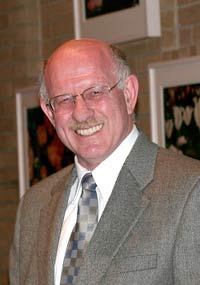
Handy Links
SLAC News Center
SLAC Today
- Subscribe
- Archives: Feb 2006-May 20, 2011
- Archives: May 23, 2011 and later
- Submit Feedback or Story Ideas
- About SLAC Today
SLAC News
Lab News
- Interactions
- Lightsources.org
- ILC NewsLine
- Int'l Science Grid This Week
- Fermilab Today
- Berkeley Lab News
- @brookhaven TODAY
- DOE Pulse
- CERN Courier
- DESY inForm
- US / LHC
SLAC Links
- Emergency
- Safety
- Policy Repository
- Site Entry Form

- Site Maps
- M & O Review
- Computing Status & Calendar
- SLAC Colloquium
- SLACspeak
- SLACspace
- SLAC Logo
- Café Menu
- Flea Market
- Web E-mail
- Marguerite Shuttle
- Discount Commuter Passes
-
Award Reporting Form
- SPIRES
- SciDoc
- Activity Groups
- Library
Stanford
Around the Bay
Dorfan Today: Getting it Straight
 Last week SLAC hosted the 9th International Workshop on Accelerator Alignment (IWAA06).
What struck me about this conference was the diversity of the attendees. Experts from all the world's particle physics, nuclear physics and photon science accelerator laboratories came together at SLAC to share their experiences and best practices.
Last week SLAC hosted the 9th International Workshop on Accelerator Alignment (IWAA06).
What struck me about this conference was the diversity of the attendees. Experts from all the world's particle physics, nuclear physics and photon science accelerator laboratories came together at SLAC to share their experiences and best practices.
SLAC's outstanding competence in geodetics, alignment and all other branches of metrology, is now more relevant than ever and is finding application to many branches of science other than accelerator-based facilities. The same expertise that built the Stanford Linear Collider (SLC) and the B-Factory accelerators and detectors now plays an essential role in every aspect of SLAC's diverse program. New concepts developed by the SLAC metrology staff continue to find relevance, not only at SLAC, but in a diversity of projects around the world.
The alignment of the main SPEAR3 ring, and the ongoing alignment of its newest beamlines, are recent examples where alignment challenges have been met with great success thanks to SLAC's geodesists and surveyors. This same group has developed new techniques and specialized equipment essential to achieving the very challenging performance specifications for our Linac Coherent Light Source (LCLS) while also providing key concepts for the straight line reference system for DESY's equivalent machine, the European X-ray Laser Project (XFEL). SLAC's alignment specialists are the leaders within the international partners devising alignment solutions for the roughly 40-kilometer long ILC.
Metrology has always been essential to the success of our large accelerator-based detectors like the Stanford Large Detector (SLD) and BaBar. Applications to the detector arena are also broadening; our metrology group was essential to the successful alignment of the Gamma-ray Large Area Space Telescope (GLAST) tracker towers built in Italy and installed in the Large Area Telescope (LAT) at SLAC, and continued refinement of such techniques will be applied to future projects like the Large Synoptic Survey Telescope (LSST), the Supernovae/Acceleration Probe (SNAP) and the Enriched Xenon Observatory (EXO).
As was evident at IWAA06, we can be justly proud of SLAC's leadership in all aspects of the science and application of metrology. Our core competency in this critical arena has allowed us to be successful both on SLAC-based projects but also as collaborations with our worldwide colleagues. Congratulations to the organizers of IWAA06 for a very successful workshop.
—Jonathan Dorfan, October 2, 2006